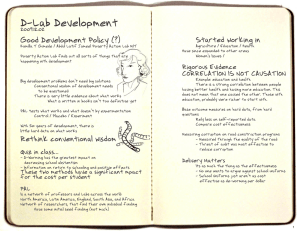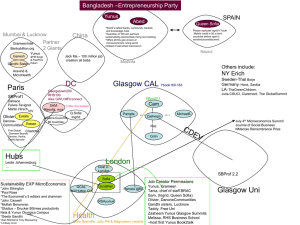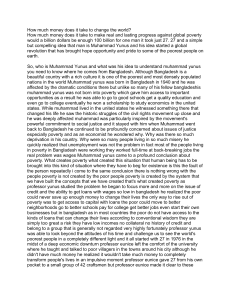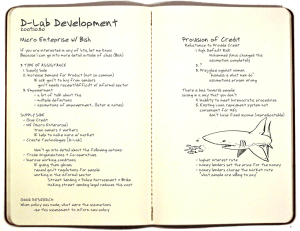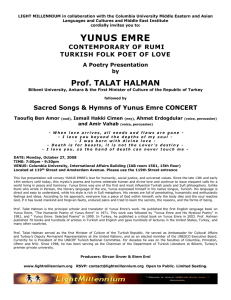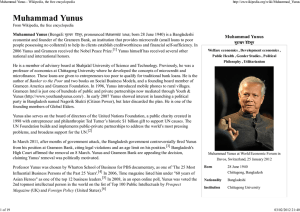SP.723: D-Lab III: Disseminating Innovations for the Common Good Susan Murcott
advertisement
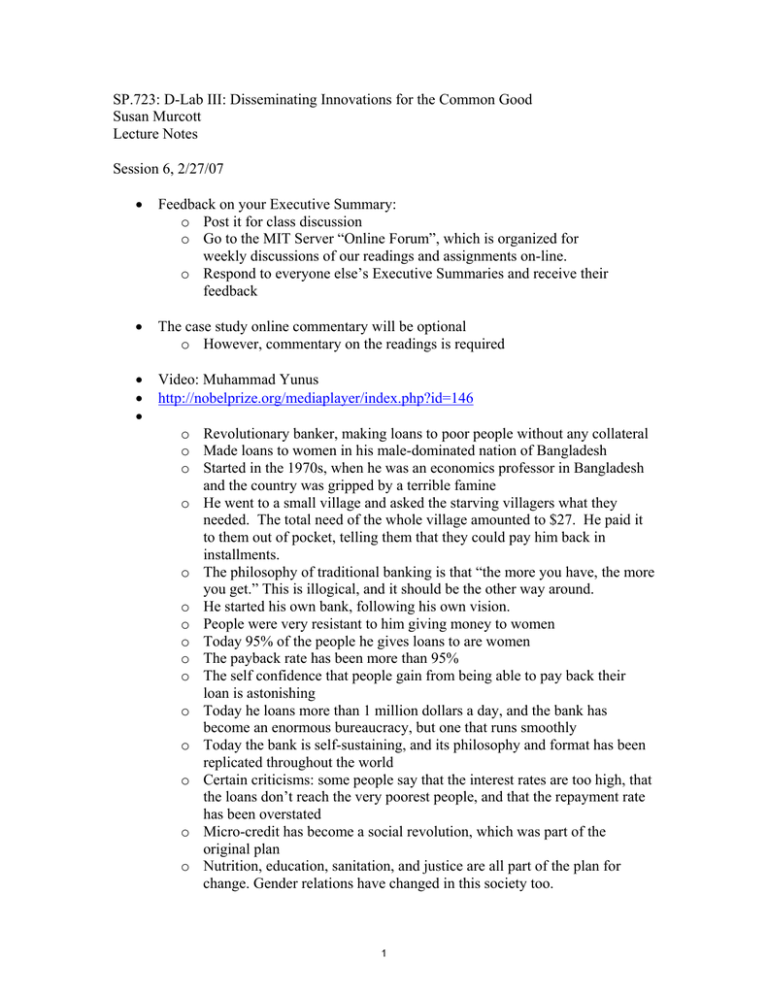
SP.723: D-Lab III: Disseminating Innovations for the Common Good Susan Murcott Lecture Notes Session 6, 2/27/07 • Feedback on your Executive Summary: o Post it for class discussion o Go to the MIT Server “Online Forum”, which is organized for weekly discussions of our readings and assignments on-line. o Respond to everyone else’s Executive Summaries and receive their feedback • The case study online commentary will be optional o However, commentary on the readings is required • • • Video: Muhammad Yunus http://nobelprize.org/mediaplayer/index.php?id=146 o Revolutionary banker, making loans to poor people without any collateral o Made loans to women in his male-dominated nation of Bangladesh o Started in the 1970s, when he was an economics professor in Bangladesh and the country was gripped by a terrible famine o He went to a small village and asked the starving villagers what they needed. The total need of the whole village amounted to $27. He paid it to them out of pocket, telling them that they could pay him back in installments. o The philosophy of traditional banking is that “the more you have, the more you get.” This is illogical, and it should be the other way around. o He started his own bank, following his own vision. o People were very resistant to him giving money to women o Today 95% of the people he gives loans to are women o The payback rate has been more than 95% o The self confidence that people gain from being able to pay back their loan is astonishing o Today he loans more than 1 million dollars a day, and the bank has become an enormous bureaucracy, but one that runs smoothly o Today the bank is self-sustaining, and its philosophy and format has been replicated throughout the world o Certain criticisms: some people say that the interest rates are too high, that the loans don’t reach the very poorest people, and that the repayment rate has been overstated o Micro-credit has become a social revolution, which was part of the original plan o Nutrition, education, sanitation, and justice are all part of the plan for change. Gender relations have changed in this society too. 1 • Discussion about Muhammad Yunus o Who got to see him when he came to MIT? What did you think? He was very mild mannered, calm, and he spoke softly. He made his idea seem so simple. o He won the Nobel Peace Prize a few months ago It’s interesting that he won the prize for peace, not economics. It says a lot about the study of economics that he didn’t win that prize. His work isn’t in theoretical economics, it’s more practical Amartya Sen won the economics Nobel Prize a few years ago for development type work o Do we know that Yunus has been able to have an effect on a macro scale? The project only went large-scale recently enough that it’s probably still too soon to say Bangladesh is one of the most densely populated countries in the world, and also one of the poorest. The birth rate there has been enormous. Should he try to lower the birth rate and encourage birth control in the same way that he works with nutrition, education, sanitation, gender equality? The way he makes them recite certain promises about nutrition, education, sanitation, gender equality seems a little bit like indoctrination People in many developing countries don’t respond well to family planning. They feel that their children are their only resource, and they can’t afford to lose that. o Yunus seems very simple and sincere. His heart is in the right place. o To what extent has the government stepped in terms of adopting or not adopting Yunus’s innovations? We would have to do some side reading to find this out – don’t know off the top of our heads o There are some for-profit micro-finance banks today, but most of them are still not-for-profit Yunus’s bank is one of the only not-for-profit micro-finance banks that has been able to break even. Most of them haven’t managed that yet. Some micro-finance banks choose to be for-profit, because it allows them to access capital markets, so they have an easier time expanding quickly, and they can become more trusted in communities even though they have higher interest rates, because they are able to build a more permanent structure. o What is his screening process for determining who does and does not get access to a loan? 2 o o o o If you don’t have strict guidelines then the process as a whole could collapse But what happens to the people who get denied loans? Who takes care of them? How can they ever get the chance to get back on their feet? What is the rate of people who get told “No” and then come back? Where does charity end and sustainable development begin? Poverty Action Lab at MIT • They do control studies on who gets help compared to who doesn’t Hearsay: we’ve heard that it hasn’t worked nearly as well in Africa and Vietnam as it has in Bangladesh This probably has more to do with the sustainability of the individual nonprofit’s model than it has to do with the nation where the project is working Yunus might just be better at running and planning it practically than a lot of other people are The staffing requirement is a huge overhead. Collecting the repayments might be much harder in an area where the population was more spread out, and not so densely populated as Bangladesh is. The distinction between a nonprofit organization and not-for-profit company The latter is a legal company that can function much like a normal corporation, but it doesn’t pay out dividends to stockholders; instead it just reinvests all of its profits A nonprofit organization has to function entirely on grants Yunus’s bank would need a means of expanding to adjust to a changing economy as people gain more wealth. The government might be useful for this sort of shift. When Yunus started out in the 70’s and 80’s, nobody thought that the poor could do it for themselves, but rather that charity would always be necessary. That’s why it was a radical idea to give them loans without collateral. What were your thoughts about Muhammad Yunus as an entrepreneur? He’s very approachable • Though, that’s easy for us to say, having all gotten higher education ourselves. • He’s still in the top one percent among Bangladeshis • He grew up upper middle class • He didn’t go from nothing to something, but that doesn’t make his idea any less spectacular He’s extremely idealistic Risk taking Persuasive Confident 3 Focus – one-pointedness Attention to detail Vision Thorough Thinking outside the box Radical, and nonchalant about it o He started out with lots of donations o Loaning to women might be a better business model than loaning to men. Women are probably more likely to pay him back, in addition to helping him empower a historically underserved population o He redefined the formal and informal sectors of the economy. He allowed the poor to help themselves, rather than just throwing money at them as unsustainable charity that was bound to be lost. • Human Development Index (HDI) o Ratio meant to measure how a country is developing. o The standard measure of this historically has been the gross domestic product (GDP) o The human development index takes into account life expectancy, health o US is eighth (.948) o Nicaragua is in the hundreds (.469) 4 MIT OpenCourseWare http://ocw.mit.edu EC.715 D-Lab: Disseminating Innovations for the Common Good Spring 2007 For information about citing these materials or our Terms of Use, visit: http://ocw.mit.edu/terms.

